On Doubt and Prayer (Part 2)

Dan Savage offers a reflection on prayer that is both humorous and poignant, noting that, as a self-identified “lapsed Catholic,” he prays only when he feels his life is in danger (in planes and when driving with his partner), and then never follows up, making him “not only an ingrate, but also a hypocrite” (see full video). Perhaps this is an updated version of the old adage, “There are no atheists in foxholes.”
Many of our synagogues fill up on Shabbat morning (and festivals) for the readings from the Torah and Prophets, and for the derash or discussion. The earlier liturgy is sparsely attended, and sometimes we ascribe the cause to the total length of Shabbat morning in shul (which, at two and a half to three and a half hours in many synagogues, is indeed too long—but that is for another essay). Perhaps there is another factor at play: people read the translations of the Hebrew prayers (increasingly cast in beautiful English language), and find the words and concepts somewhere between challenging and impossible.
Listening to the texts of Torah and Prophets invites us to engage our critical faculties and historical perspective, especially within the Conservative/Reform world, in which rabbis are trained in historical-critical methodologies. There is no requirement of belief or personal theology to engage with our ancient sources.
But to say (even quietly to ourselves) the words of the liturgy, printed on the page of a siddur, or even to listen to them chanted and sung (even with the most beautiful and stirring melodies) seems to imply our consent and agreement. After all, that is precisely what is implied by the word “Amen!”
According to legend, the Hasidic master Rabbi Levi Yitzhak of Berdichev was visited by a well-known atheist. After a silence, the rabbi turned to his visitor and said, “You know, the God you don’t believe in—I don’t believe in that God either!” (cited in this sermon by Rabbi Marc Soloway). There is a simple mechanical way in which much of our liturgy can be understood, an approach I often use with young children, which leaves intact all of the challenges and difficulties found by the modern person who looks closely at the words and concepts of the siddur.
In a time of drought, how can we say that God is mashiv ha-ruach u-morid ha-gashem (the One who brings the winds and causes rain to descend)? With our modern (partial) mastery of climatology, do we really think that any special prayer or ritual will cause rain to fall? (Notwithstanding the classic clip from The Frisco Kid in which the rabbi offers some quite modern theology with surprising results.)
We are challenged by the simple words at the heart of the second blessing of the ‘Amidah, which affirm God as Mechayei ha-meitim (the One who revives the dead). Dr. Neil Gillman, professor of Jewish Philosophy at JTS, devoted an entire book to an exploration of this text (The Death of Death: Resurrection and Mortality in Jewish Thought), and offers several ways in which these words are not only meaningful to the modern Jew, but critical to our sense of humanity. Our humanity, perhaps, is found in affirming that we are not entirely to be described by what happens between birth and death. We are eternal not only in human memories, precious though they be, but in seeing ourselves as a part of the divine, an Eternal Presence that abides through all human history and beyond.
We need not expect our singular petitions and hopes, even of the greatest urgency, to be answered immediately, or ever. We need not suspend or abandon our understanding of history and science. On the contrary, if we bring the best and most piercing of who we are to the words, texts, and melodies of our liturgy, we will find echoes, meaning, and hope in this ancient source and resource.
(To be continued.)
As always, I am interested in hearing comments and reflections on these thoughts about prayer and liturgy. You may reach me at sabarth@jtsa.edu.



